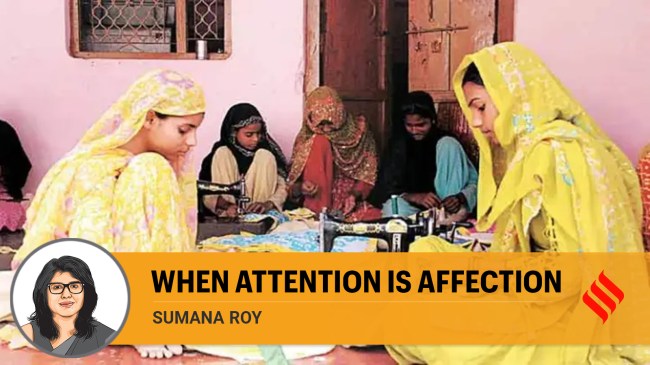Opinion Arre ji sunte ho: When attention is affection
From 'sunte ho' to 'bakbak', the long history of shushing women
 I’m thinking of the domestic, the private, even the intimate — less silencing and more of ignoring and neglecting the sonic that characterises both the subject and form of women’s speech. (Representative/ File)
I’m thinking of the domestic, the private, even the intimate — less silencing and more of ignoring and neglecting the sonic that characterises both the subject and form of women’s speech. (Representative/ File) “Sunte ho?”, “Shunchho?” We hear the history of women in these words every day; but even the whistle of the pressure cooker sounds more consequential than a woman saying “Are you listening?” The history of women has been a history of not being heard, one that has come to solidify into a mark of showing respect: The wife not calling her man by his name, a noun, but with a verb instead. “Suniye na?” listen to me, please, is the opposite of the call of “Hazir ho” in a court of law; it is a history of pleading for attention (Attention is affection — substituting a few letters in the first word results in the other, that is not an accident).
But attention is not an accident. Rarely is attention available, even rarer is a response, so that the woman needs to ask about the quality of her cooking during a meal since no acknowledgement is forthcoming. This seeking of attention, the need to be heard — “sunte ho?” — makes her repeat everything she says, for she’s not sure whether he’s heard her. Hence, the easy characterisation of the woman as a nag: Repetition, which can easily transform into the rhythm-endowing character of the refrain in a poem or song, sounds like nagging when it emerges from a concerned woman.
That the woman asking for the listener’s attention is the norm is emphasised by the corpus of Hindi film songs of the “suniye-kahiye” genre where it is usually the man singing for the woman’s attention — it is such a deviation from our domestic experience that the moment has to be embalmed into a quasi-Petrarchan romantic trope. Once past that stage of wooing, women can speak but they need not be heard or heeded — institutions, because they are usually constructed according to a male architecture of emotions, are like recording studios that block out certain kinds of sounds. In that, most institutions are like Julius Caesar to his wife Calpurnia on the Ides of March.
Mary Beard, in her extraordinary essay ‘The Public Voice of Women’, writes, “I want to start very near the beginning of the tradition of Western literature, and its first recorded example of a man telling a woman to ‘shut up’; telling her that her voice was not to be heard in public. I’m thinking of a moment immortalised at the start of the Odyssey… The process starts in the first book with Penelope coming down from her private quarters into the great hall, to find a bard performing to throngs of her suitors; he’s singing about the difficulties the Greek heroes are having in reaching home. She isn’t amused, and in front of everyone, she asks him to choose another, happier number. At which point young Telemachus intervenes: ‘Mother,’ he says, ‘go back up into your quarters, and take up your own work, the loom and the distaff … speech will be the business of men, all men, and of me most of all; for mine is the power in this household.’ And off she goes, back upstairs.” Beard traces a history of nearly 2,000 years of the public silencing of women.
I’m thinking of the domestic, the private, even the intimate — less silencing and more of ignoring and neglecting the sonic that characterises both the subject and form of women’s speech. It is not just the infrasound and ultrasound character of the female sonic that men seem unable to hear. Some of these seem unbearable to the tonal tolerance threshold of men and their institutions, which are ordered to male needs, demands, and instructions. Take the kind of sound called “hysterical”, for instance — the word hysteria, of course, derives from the Greek “hystera”, meaning “uterus”; it’s a kind of pitch and tone that scares and disgusts the patriarchal ear. It’s not just the sounds that escape her mouth, summarised in the onomatopoeia of “bakbak”, “kichkich”, “kaikai”; there’s also the sound made by her hands — noisy pots and pans signify an “alakkhi”, a noisy woman who brings bad luck to the family.
There are only a few kinds of sonic registers that the male ear can record: Moaning and mourning, the first of sexual pleasure, as if grading the partner’s performance, the second a sound of public grieving; crooning and cursing, the first that has, as Virginia Woolf tells us in A Room of One’s Own (1929), given us our oral literature of lullabies, the second the sound of Draupadi.
My mother, now unable to walk without assistance, spends hours popping plastic bubble wrap. But there are more conversation-less hours in her day than there are bubbles to burst. She now waits nervously to do this when people aren’t around — she’s been told that the sound of the bubbles popping “disturbs” the house.
And yet we call it the mother tongue?
Roy, a poet and writer, is associate professor of creative writing, Ashoka University. Views are personal






